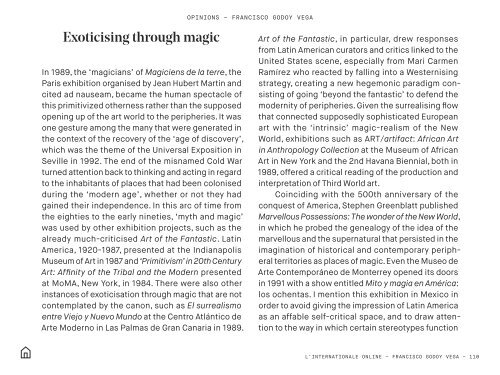DECOLONISING MUSEUMS
decolonisingmuseums_pdf-final
decolonisingmuseums_pdf-final
You also want an ePaper? Increase the reach of your titles
YUMPU automatically turns print PDFs into web optimized ePapers that Google loves.
OPINIONS – FRANCISCO GODOY VEGA<br />
Exoticising through magic<br />
In 1989, the ‘magicians’ of Magiciens de la terre, the<br />
Paris exhibition organised by Jean Hubert Martin and<br />
cited ad nauseam, became the human spectacle of<br />
this primitivized otherness rather than the supposed<br />
opening up of the art world to the peripheries. It was<br />
one gesture among the many that were generated in<br />
the context of the recovery of the ‘age of discovery’,<br />
which was the theme of the Universal Exposition in<br />
Seville in 1992. The end of the misnamed Cold War<br />
turned attention back to thinking and acting in regard<br />
to the inhabitants of places that had been colonised<br />
during the ‘modern age’, whether or not they had<br />
gained their independence. In this arc of time from<br />
the eighties to the early nineties, ‘myth and magic’<br />
was used by other exhibition projects, such as the<br />
already much-criticised Art of the Fantastic. Latin<br />
America, 1920-1987, presented at the Indianapolis<br />
Museum of Art in 1987 and ‘Primitivism’ in 20th Century<br />
Art: Affinity of the Tribal and the Modern presented<br />
at MoMA, New York, in 1984. There were also other<br />
instances of exoticisation through magic that are not<br />
contemplated by the canon, such as El surrealismo<br />
entre Viejo y Nuevo Mundo at the Centro Atlántico de<br />
Arte Moderno in Las Palmas de Gran Canaria in 1989.<br />
Art of the Fantastic, in particular, drew responses<br />
from Latin American curators and critics linked to the<br />
United States scene, especially from Mari Carmen<br />
Ramírez who reacted by falling into a Westernising<br />
strategy, creating a new hegemonic paradigm consisting<br />
of going ‘beyond the fantastic’ to defend the<br />
modernity of peripheries. Given the surrealising flow<br />
that connected supposedly sophisticated European<br />
art with the ‘intrinsic’ magic-realism of the New<br />
World, exhibitions such as ART/artifact: African Art<br />
in Anthropology Collection at the Museum of African<br />
Art in New York and the 2nd Havana Biennial, both in<br />
1989, offered a critical reading of the production and<br />
interpretation of Third World art.<br />
Coinciding with the 500th anniversary of the<br />
conquest of America, Stephen Greenblatt published<br />
Marvellous Possessions: The wonder of the New World,<br />
in which he probed the genealogy of the idea of the<br />
marvellous and the supernatural that persisted in the<br />
imagination of historical and contemporary peripheral<br />
territories as places of magic. Even the Museo de<br />
Arte Contemporáneo de Monterrey opened its doors<br />
in 1991 with a show entitled Mito y magia en América:<br />
los ochentas. I mention this exhibition in Mexico in<br />
order to avoid giving the impression of Latin America<br />
as an affable self-critical space, and to draw attention<br />
to the way in which certain stereotypes function<br />
L’INTERNATIONALE ONLINE – FRANCISCO GODOY VEGA – 110


